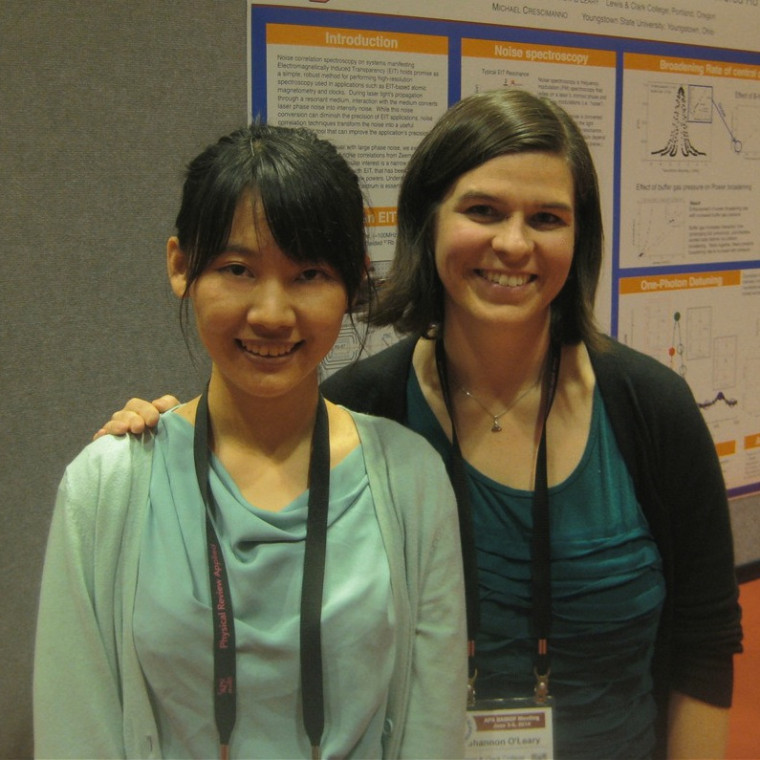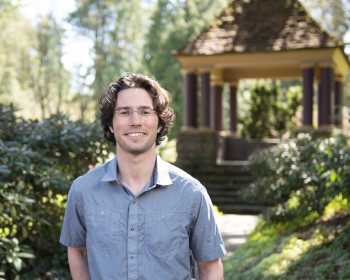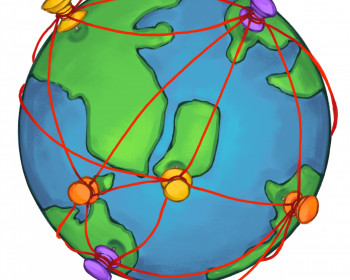Summer student research: Measuring magnetic fields
Open gallery

Lewis & Clark students remain closely engaged with their fields of study during the summer months, and many make meaningful contributions to scholarship by collaborating with faculty on innovative research. Aojie Zheng ’15 is working with Assistant Professor of Physics Shannon O’Leary to study how laser light can be used to detect and measure magnetic fields. She reflects on this experience in the following Q&A.
What are you researching?
I am researching how laser light interacts with rubidium atoms, and how that interaction can be used to detect super-sensitive magnetic fields such as those produced by the human brain. The unique aspect of my research is that I have studied how random fluctuations in a laser’s operation can be used to improve the precision of magnetic field measurement. Most labs use a “perfect” laser that has minimal random fluctuations, but in my case random fluctuation can be utilized to increase the precision of measurement.
What initially sparked your interest in this project, and how does it relate to your previous coursework?
Advanced electromagnetics and quantum mechanics are my favorite classes. I always like to be challenged by new, exciting, and complex ideas, and quantum optics really fits the bill. This is my second summer working with Professor O’Leary, and I enjoy applying what I’ve learned in class to real world problems.
How has your Lewis & Clark education been enhanced by close collaboration with faculty?
Working with Professor O’Leary this summer has been the best part of my college education so far. In June, I attended the 45th annual meeting of the American Physical Society Division of Atomic, Molecular, and Optical Physics in Wisconsin. As an undergraduate student, I was able to present a scientific poster of our research in a room of researchers from Harvard and MIT. Also, Nobel laureate Eric A. Cornell came by our poster and asked lots of interesting questions. Working on this project has been an incredibly rewarding experience and has helped me determine the field of physics I want to study in graduate school.
Does your research have potential to be applied in the real world or to influence other work in your field?
Magnetic fields are produced by everything around us: Earth creates a magnetic field and so does the human body. Earth’s magnetic field is relatively easy to detect because it is large. Magnetic fields produced by the human body are about 10 million times smaller than that, making them difficult to measure. Improving our ability to measure the small magnetic fields produced by the human brain or heart could lead to the development of more advanced medical diagnostics.
How will this research experience hopefully impact your future studies or professional pursuits?
This semester, I will apply for graduate programs in physics to continue conducting research in the field of atomic optics. Professor O’Leary has done so much to prepare me for success, and her guidance in combination with what I’ve learned from conducting summer research has made me feel highly equipped for the future.
About the Rogers Science Research Program
The John S. Rogers Science Research Program allows students to pursue graduate-level research in the natural and mathematical sciences. It emphasizes strong communication skills, requiring students to publicly present their findings. This summer, more than 50 students are being sponsored to study such topics as memory formation, cybersecurity, and the impact of nicotine on flies.
“We’re not asking you, ‘What’s the answer?’ We’re saying, ‘What’s the question?’” said Michael Broide, director of the Rogers program and chair of the physics department. “I think what sets our program apart is that regardless of what project you are on, we’re all going to come together as a group to present what we’re doing in as accessible a way as possible. In science, it’s such an important skill to be able to explain cogently what you’re doing.”
Students make their final research presentations at the Rogers summer science poster session, held in conjunction with the Science Without Limits Symposium. Scheduled for September 17, the poster session is free and open to the public.
Katrina Staaf ’16 contributed to this story.
More Newsroom Stories
Public Relations is located in McAfee on the Undergraduate Campus.
MSC: 19
email public@lclark.edu
voice 503-768-7970
Public Relations
Lewis & Clark
615 S. Palatine Hill Road MSC 19
Portland OR 97219

